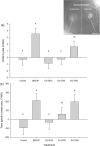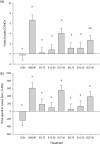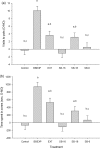Electrophysiologically and behaviourally active semiochemicals identified from bed bug refuge substrate
- PMID: 32165700
- PMCID: PMC7067832
- DOI: 10.1038/s41598-020-61368-6
Electrophysiologically and behaviourally active semiochemicals identified from bed bug refuge substrate
Abstract
Bed bugs are pests of public health importance due to their relentless biting habits that can lead to allergies, secondary infections and mental health issues. When not feeding on human blood bed bugs aggregate in refuges close to human hosts. This aggregation behaviour could be exploited to lure bed bugs into traps for surveillance, treatment efficacy monitoring and mass trapping efforts, if the responsible cues are identified. The aim of this study was to identify and quantify the bed bug aggregation pheromone. Volatile chemicals were collected from bed bug-exposed papers, which are known to induce aggregation behaviour, by air entrainment. This extract was tested for behavioural and electrophysiological activity using a still-air olfactometer and electroantennography, respectively. Coupled gas chromatography-electroantennography (GC-EAG) was used to screen the extract and the GC-EAG-active chemicals, benzaldehyde, hexanal, (E)-2-octenal, octanal, nonanal, decanal, heptanal, (R,S)-1-octen-3-ol, 3-carene, β-phellandrene, (3E,5E)-octadien-2-one, (E)-2-nonenal, 2-decanone, dodecane, nonanoic acid, 2-(2-butoxyethoxy)ethyl acetate, (E)-2-undecanal and (S)-germacrene D, were identified by GC-mass spectrometry and quantified by GC. Synthetic blends, comprising 6, 16, and 18 compounds, at natural ratios, were then tested in the still-air olfactometer to determine behavioural activity. These aggregation chemicals can be manufactured into a lure that could be used to improve bed bug management.
Conflict of interest statement
The authors E.N.I.W., J.G.L., M.M.C., M.A.B. and J.A.P. are inventors of the following patent: Weeks, E.N.I., Logan J.G., Cameron M.M., Birkett M.A. & Pickett J.A. Bed bug lure. ed. UK Intellectual Property Office. United Kingdom. P52250GB. GB Patent Application No 1616815.5 filed 04 Oct 2016 (claiming priority from G.B. Patent Application No 1517546.6 – filed 05 Oct 2015). The patent is licensed to Vecotech Ltd., a company co-founded by two of the authors (M.M.C. and J.G.L.). V.A.B. works for Vectotech Ltd. The other authors (S.J.W., S.A.G. and J.C.C.) certify that they have no affiliations with or involvement in any organization or entity with any financial interest in the subject matter or materials discussed in this manuscript.
Figures




Similar articles
-
Bed bug aggregation pheromone finally identified.Angew Chem Int Ed Engl. 2015 Jan 19;54(4):1135-8. doi: 10.1002/anie.201409890. Epub 2014 Dec 21. Angew Chem Int Ed Engl. 2015. PMID: 25529634
-
Two compounds in bed bug feces are sufficient to elicit off-host aggregation by bed bugs, Cimex lectularius.Pest Manag Sci. 2017 Jan;73(1):198-205. doi: 10.1002/ps.4286. Epub 2016 May 10. Pest Manag Sci. 2017. PMID: 27060680
-
Semiochemicals of the common bed bug, Cimex lectularius L. (Hemiptera: Cimicidae), and their potential for use in monitoring and control.Pest Manag Sci. 2011 Jan;67(1):10-20. doi: 10.1002/ps.2024. Epub 2010 Sep 21. Pest Manag Sci. 2011. PMID: 20859928 Review.
-
A bioassay for studying behavioural responses of the common bed bug, Cimex lectularius (Hemiptera: Cimicidae) to bed bug-derived volatiles.Bull Entomol Res. 2011 Feb;101(1):1-8. doi: 10.1017/S0007485309990599. Epub 2010 Jan 27. Bull Entomol Res. 2011. PMID: 20102661
-
Semiochemicals modulating bed bug behaviour.Curr Opin Insect Sci. 2024 Aug;64:101207. doi: 10.1016/j.cois.2024.101207. Epub 2024 May 29. Curr Opin Insect Sci. 2024. PMID: 38821142 Review.
Cited by
-
High-throughput behavioral phenotyping of tiny arthropods: Chemosensory traits in a mesostigmatic hematophagous mite.J Exp Zool A Ecol Integr Physiol. 2023 Jan;339(1):46-62. doi: 10.1002/jez.2651. Epub 2022 Sep 2. J Exp Zool A Ecol Integr Physiol. 2023. PMID: 36052497 Free PMC article.
-
Varroa Volatiles Offer Chemical Cues to Honey Bees for Initial Parasitic Recognition.Biomolecules. 2025 Jan 6;15(1):66. doi: 10.3390/biom15010066. Biomolecules. 2025. PMID: 39858461 Free PMC article.
-
The Olfactory Chemosensation of Hematophagous Hemipteran Insects.Front Physiol. 2021 Aug 9;12:703768. doi: 10.3389/fphys.2021.703768. eCollection 2021. Front Physiol. 2021. PMID: 34434117 Free PMC article. Review.
-
Volatile Organic Compounds: A Promising Tool for Bed Bug Detection.Int J Environ Res Public Health. 2023 Mar 22;20(6):5214. doi: 10.3390/ijerph20065214. Int J Environ Res Public Health. 2023. PMID: 36982123 Free PMC article. Review.
-
Aldehyde-specific responses of olfactory sensory neurons in the praying mantis.Sci Rep. 2021 Jan 20;11(1):1856. doi: 10.1038/s41598-021-81359-5. Sci Rep. 2021. PMID: 33473161 Free PMC article.
References
-
- Boase C. Bed-bugs - reclaiming our cities. Biologist. 2004;51:102–103.
-
- United Kingdom Ministry of Health. Report of committee on the eradication of bed bugs. Ministry of Health Report No. 72., Her Majesty’s Stationary Office, London, UK (1933).
-
- Pinto L. Bed bugs…they’re back. Pest Control. 1999;67:10–12.
Publication types
MeSH terms
Substances
Grants and funding
LinkOut - more resources
Full Text Sources
Medical
Miscellaneous

